4.1 Behavior Genetics: Predicting Individual Differences

behavior genetics the study of the relative power and limits of genetic and environmental influences on behavior.
4-
environment every nongenetic influence, from prenatal nutrition to the people and things around us.
If Chelsea Clinton, daughter of former President Bill Clinton and former Secretary of State Hillary Rodham Clinton, becomes a politician, should we attribute her superior political talent to her “White House genes”? To growing up in a politically savvy environment? To high expectations? Such questions intrigue behavior geneticists, who study our differences and weigh the effects and the interplay of heredity and environment.
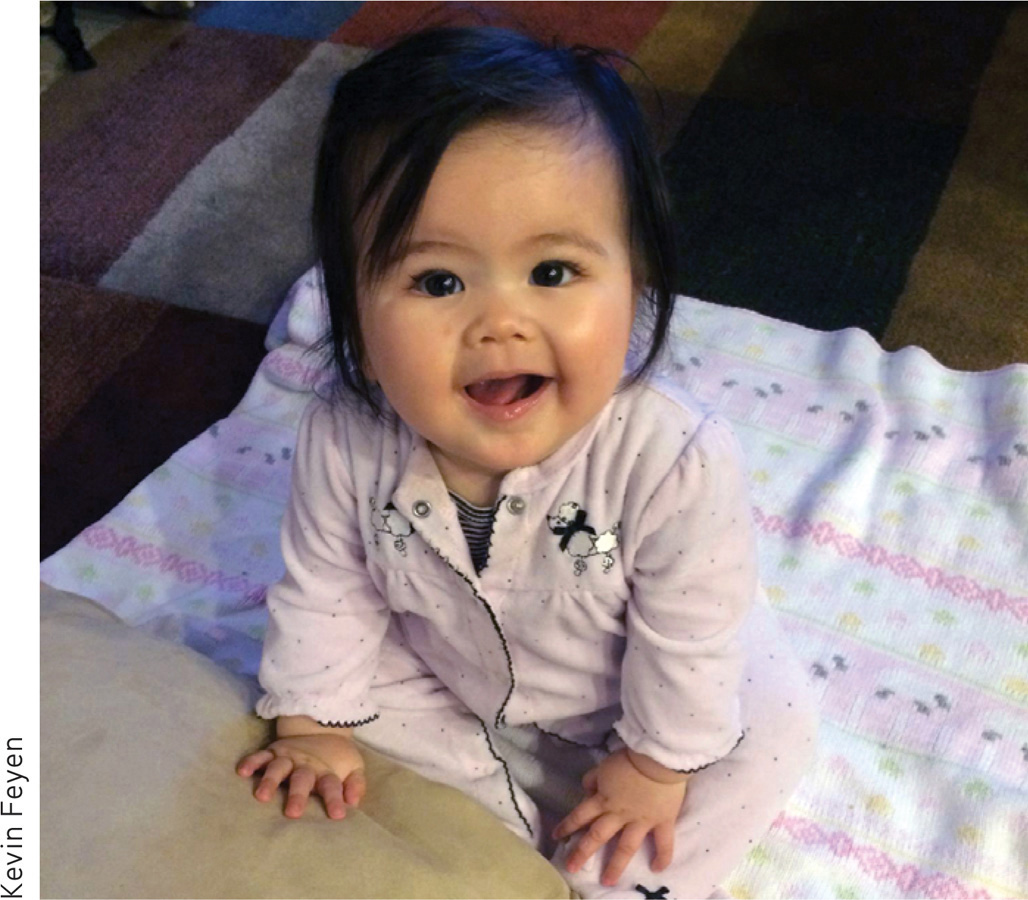
Genes: Our Codes for Life
chromosomes threadlike structures made of DNA molecules that contain the genes.
DNA (deoxyribonucleic acid) a complex molecule containing the genetic information that makes up the chromosomes.
Behind the story of our body and of our brain—
genes the biochemical units of heredity that make up the chromosomes; segments of DNA capable of synthesizing proteins.
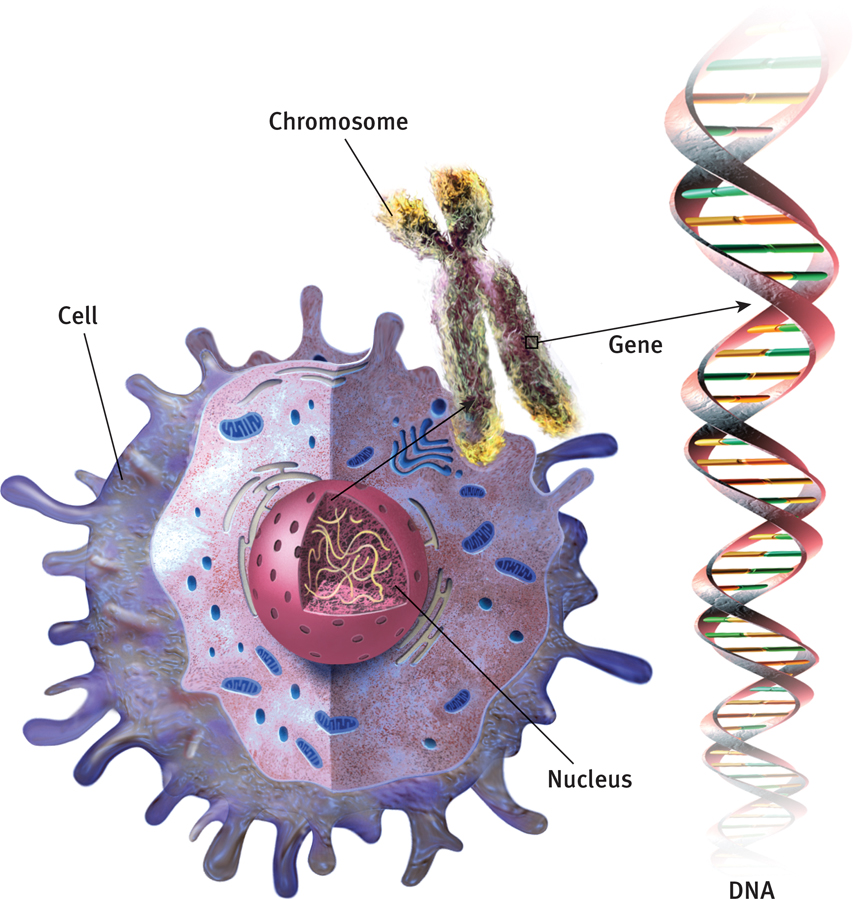
 Figure 4.1
Figure 4.1The life code The nucleus of every human cell contains chromosomes, each of which is made up of two strands of DNA connected in a double helix. Genes are DNA segments that, when expressed (turned on) direct the development of proteins that influence a person’s individual development.
genome the complete instructions for making an organism, consisting of all the genetic material in that organism’s chromosomes.
135
Genetically speaking, every other human is nearly your identical twin. Human genome researchers have discovered the common sequence within human DNA. This shared genetic profile makes us humans, rather than tulips, bananas, or chimpanzees.
“We share half our genes with the banana.”
Evolutionary biologist Robert May, president of Britain’s Royal Society, 2001
We aren’t all that different from our chimpanzee cousins. At a genetic level, humans and chimpanzees are 96 percent identical (Mikkelsen et al., 2005). At “functionally important” DNA sites, this number reaches 99.4 percent (Wildman et al., 2003)! Yet that wee 0.6 percent difference matters. Shakespeare intricately wove 17,677 words into his literary masterpieces. Despite some remarkable abilities, chimpanzees do not compose sonnets.
Small differences matter among other species, too. Common chimpanzees and bonobos resemble each other in many ways. They should—
“Your DNA and mine are 99.9 percent the same…. At the DNA level, we are clearly all part of one big worldwide family.”
Francis Collins, Human Genome Project director, 2007
The occasional variations found at particular gene sites in human DNA fascinate geneticists and psychologists. Slight person-
Most of our traits have complex genetic roots. How tall you are, for example, reflects the size of your face, vertebrae, leg bones, and so forth—
Question
eEa1zrWY/ddS3tfUDqIlySFfo8/ImHHLHafD2lPt9wkJHy2HLR9eQjpBSGpK9392pa/ZVkUScpWZRHvvgp9h5mQwxw52UwhihfX8fUEO4JJRt8vnfg258OBgAavBi6gsg8T+dRXzYZoG8ALNCBIO4YT9P4rxKas1XqdWqVFdWrA/fFD1a4eEqFlEFsK9sv2+qFU7NmwkTyhvF4Kx0GO1qwWGeuIZ2naPhi+L6qU0FeaTO1/A0Gkw1AWuh1O0TX1FYCBgrUkDkHSROMgLvEHaAq8fy3ePyju2KpqfF6p+0c8LlCzWRETRIEVAL PRACTICE
- Put the following cell structures in order from smallest to largest: nucleus, gene, chromosome
gene, chromosome, nucleus
- When the mother’s egg and the father’s sperm unite, each contributes 23 ______________.
chromosomes
Twin and Adoption Studies

4-
To scientifically tease apart the influences of heredity and environment, behavior geneticists could wish for two types of experiments. The first would control heredity while varying the home environment. The second would control the home environment while varying heredity. Although such experiments with human infants would be unethical, nature has done this work for us.
identical twins (monozygotic twins) develop from a single fertilized egg that splits in two, creating two genetically identical organisms.
Identical Versus Fraternal Twins
Identical (monozygotic) twins develop from a single fertilized egg that splits in two. Thus they are genetically identical—

 Figure 4.2
Figure 4.2Same fertilized egg, same genes; different eggs, different genes Identical twins develop from a single fertilized egg, fraternal twins from two.
136
- Although identical twins have the same genes, they don’t always have the same number of copies of those genes. That variation helps explain why one twin may have a greater risk for certain illnesses and disorders, including schizophrenia (Maiti et al., 2011).
- Most identical twins share a placenta during prenatal development, but one of every three sets has separate placentas. One twin’s placenta may provide slightly better nourishment, which may contribute to identical twin differences (Davis et al., 1995b; Phelps et al., 1997; Sokol et al., 1995).
fraternal twins (dizygotic twins) develop from separate fertilized eggs. They are genetically no closer than ordinary brothers and sisters, but they share a prenatal environment.
Fraternal (dizygotic) twins develop from two separate fertilized eggs. As womb-
Shared genes can translate into shared experiences. A person whose identical twin has autism spectrum disorder, for example, has about a 3 in 4 risk of being similarly diagnosed. If the affected twin is fraternal, the co-
Are identical twins also behaviorally more similar than fraternal twins? Studies of thousands of twin pairs in Germany, Australia, and the United States have found that on the personality traits of extraversion (outgoingness) and neuroticism (emotional instability) identical twins report much greater similarity than do fraternal twins (Kandler et al., 2011; Laceulle et al., 2011; Loehlin, 2012). Genes also influence many specific behaviors. For example, compared with rates for fraternal twins, drinking and driving convictions are 12 times greater among those who have an identical twin with such a conviction (Beaver & Barnes, 2012). As twins grow older, their behaviors remain similar (McGue & Christensen, 2013).
Identical twins, more than fraternal twins, also report being treated alike. So, do their experiences rather than their genes account for their similarities? No. Studies have shown that identical twins whose parents treated them alike (for example, dressing them identically) were not psychologically more alike than identical twins who were treated less similarly (Kendler et al., 1994; Loehlin & Nichols, 1976). In explaining individual differences, genes matter.

Separated Twins
Imagine the following science fiction experiment: A mad scientist decides to separate identical twins at birth, then raise them in differing environments. Better yet, consider a true story:
137
Twins Lorraine and Levinia Christmas, driving to deliver Christmas presents to each other near Flitcham, England, collided (Shepherd, 1997).
On a chilly February morning in 1979, some time after divorcing his first wife, Linda, Jim Lewis awoke in his modest home next to his second wife, Betty. Determined that this marriage would work, Jim made a habit of leaving love notes to Betty around the house. As he lay in bed he thought about others he had loved, including his son, James Alan, and his faithful dog, Toy.
Jim looked forward to spending part of the day in his basement woodworking shop, where he enjoyed building furniture, picture frames, and other items, including a white bench now circling a tree in his front yard. Jim also liked to spend free time driving his Chevy, watching stock-
In 2009, thieves broke into a Berlin store and stole jewelry worth $6.8 million. One thief left a drop of sweat—
Jim was basically healthy, except for occasional half-
What was extraordinary about Jim Lewis, however, was that at that same moment (we are not making this up) there existed another man—

 For a 2-
For a 2-
One month later, the brothers became the first of many separated twin pairs tested by University of Minnesota psychologist Thomas Bouchard and his colleagues (Miller, 2012). The brothers’ voice intonations and inflections were so similar that, hearing a playback of an earlier interview, Jim Springer guessed “That’s me.” Wrong—
Aided by publicity in magazine and newspaper stories, Bouchard (2009) and his colleagues located and studied 74 pairs of identical twins raised apart. They continued to find similarities not only of tastes and physical attributes but also of personality (characteristic patterns of thinking, feeling, and acting), abilities, attitudes, interests, and even fears.

138
In Sweden, researchers identified 99 separated identical twin pairs and more than 200 separated fraternal twin pairs (Pedersen et al., 1988). Compared with equivalent samples of identical twins raised together, the separated identical twins had somewhat less identical personalities. Still, separated twins were more alike if genetically identical than if fraternal. And separation shortly after birth (rather than, say, at age 8) did not amplify their personality differences.
Bouchard’s famous twin research was, appropriately enough, conducted in Minneapolis, the “Twin City” (with St. Paul) and home to the Minnesota Twins baseball team.
Stories of startling twin similarities have not impressed critics, who remind us that “The plural of anecdote is not data.” They have noted that if any two strangers were to spend hours comparing their behaviors and life histories, they would probably discover many coincidental similarities. If researchers created a control group of biologically unrelated pairs of the same age, sex, and ethnicity, who had not grown up together but who were as similar to one another in economic and cultural background as are many of the separated twin pairs, wouldn’t these pairs also exhibit striking similarities (Joseph, 2001)? Twin researchers have replied that separated fraternal twins do not exhibit similarities comparable to those of separated identical twins.
Coincidences are not unique to twins. Patricia Kern of Colorado was born March 13, 1941, and named Patricia Ann Campbell. Patricia DiBiasi of Oregon also was born March 13, 1941, and named Patricia Ann Campbell. Both had fathers named Robert, worked as bookkeepers, and at the time of this comparison had children ages 21 and 19. Both studied cosmetology, enjoyed oil painting as a hobby, and married military men, within 11 days of each other. They are not genetically related. (From an AP report, May 2, 1983.)
Even the impressive data from personality assessments are clouded by the reunion of many of the separated twins some years before they were tested. Moreover, identical twins share an appearance, and the responses it evokes. Adoption agencies also tend to place separated twins in similar homes. Despite these criticisms, the striking twin-
Biological Versus Adoptive Relatives
For behavior geneticists, nature’s second real-
The stunning finding from studies of hundreds of adoptive families is that people who grow up together, whether biologically related or not, do not much resemble one another in personality (McGue & Bouchard, 1998; Plomin, 2011; Rowe, 1990). In personality traits such as extraversion and agreeableness, people who have been adopted are more similar to their biological parents than to their caregiving adoptive parents.
The finding is important enough to bear repeating: The environment shared by a family’s children has virtually no discernible impact on their personalities. Two adopted children raised in the same home are no more likely to share personality traits with each other than with the child down the block. Heredity shapes other primates’ personalities, too. Macaque monkeys raised by foster mothers exhibited social behaviors that resemble their biological, rather than foster, mothers (Maestripieri, 2003). Add in the similarity of identical twins, whether they grow up together or apart, and the effect of a shared raising environment seems shockingly modest.
What we have here is perhaps “the most important puzzle in the history of psychology,” contended Steven Pinker (2002): Why are children in the same family so different? Why does shared family environment have so little effect on children’s personalities? Is it because each sibling experiences unique peer influences and life events? Because sibling relationships ricochet off each other, amplifying their differences? Because siblings—
“Mom may be holding a full house while Dad has a straight flush, yet when Junior gets a random half of each of their cards his poker hand may be a loser.”
David Lykken (2001)
The genetic leash may limit the family environment’s influence on personality, but it does not mean that adoptive parenting is a fruitless venture. Parents do influence their children’s attitudes, values, manners, politics, and faith (Reifman & Cleveland, 2007). Religious involvement is genetically influenced (Steger et al., 2011). But a pair of adopted children or identical twins will, especially during adolescence, have more similar religious beliefs if raised together (Koenig et al., 2005). Parenting matters!
139

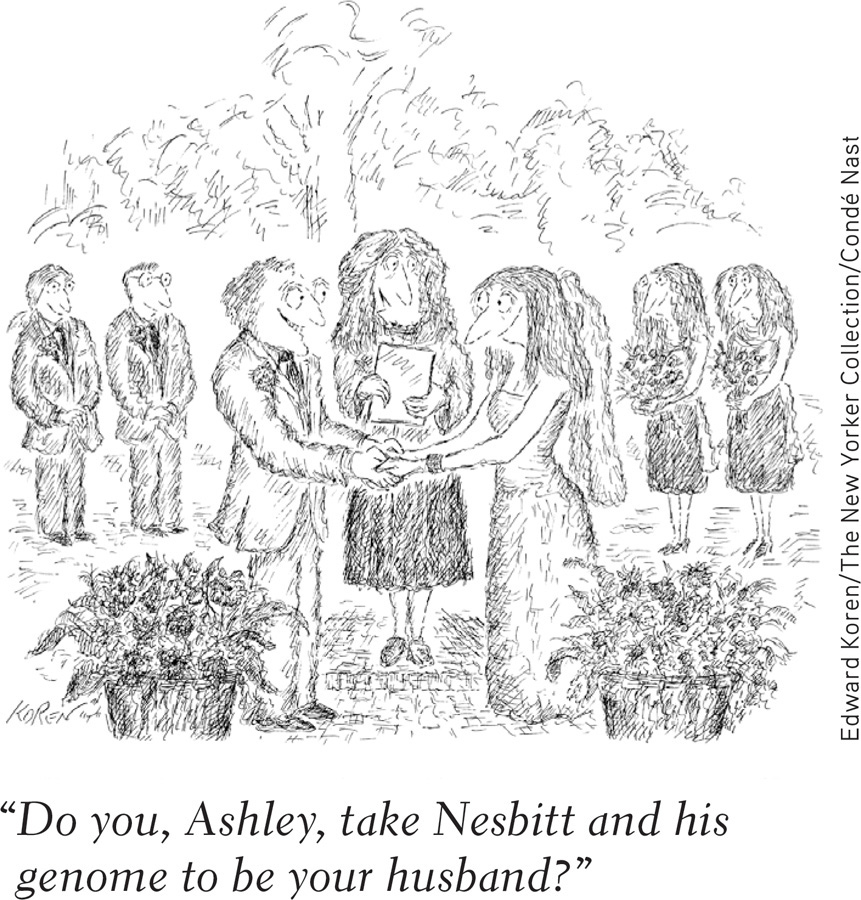
Moreover, in adoptive homes, child neglect and abuse and even parental divorce are rare. (Adoptive parents are carefully screened; natural parents are not.) So it is not surprising that studies have shown that, despite a somewhat greater risk of psychological disorder, most adopted children thrive, especially when adopted as infants (Loehlin et al., 2007; van IJzendoorn & Juffer, 2006; Wierzbicki, 1993). Seven in eight adopted children have reported feeling strongly attached to one or both adoptive parents. As children of self-

Question
lOLPZUuNgQvf24+lwCjFJf8wuWEvisnC9pEq4WwFXfUuDM6PNz/kRKN7/VMcCvH9Xz4vki5a9QOywN4zBemfGjkedU+cl9+ozrw8U2bgs7a/AybkXQb0WJssoG+eJZ0MhlqTz7Q5Rz6fZqkzV9ck3MBJ+oY6cJNzbBylNlUv1Lgvjtqk455W6Ai3EWpDbxCsgANxH34iPLRGduCDLwA5Uwz09Y1+K4zvAYkjLExudEWTofrT+ZcZINQxf+/WselxIfT1Y/n/zZkz9n8t55jI4CQLdCczMKAY9Gxp06ciC/4S3UBVtBTMkUAuBijwqVuZdTifg2vkwfIRwv0hJz+y55cy/UCUUrbWdfEom5wSD9kqf4IjMUPCB18FVuIcnsoZpXmQzKDJ6zbOrk9HkEjARJPp+f/E0rTzaKtBd9qN/wA=140
RETRIEVAL PRACTICE
- How do researchers use twin and adoption studies to learn about psychological principles?
Researchers use twin and adoption studies to understand how much variation among individuals is due to genetic makeup and how much to environmental factors. Some studies compare the traits and behaviors of identical twins (same genes) and fraternal twins (different genes, as in any two siblings). They also compare adopted children with their adoptive and biological parents. Some studies compare traits and behaviors of twins raised together or separately.
Temperament and Heredity
temperament a person’s characteristic emotional reactivity and intensity.
4-
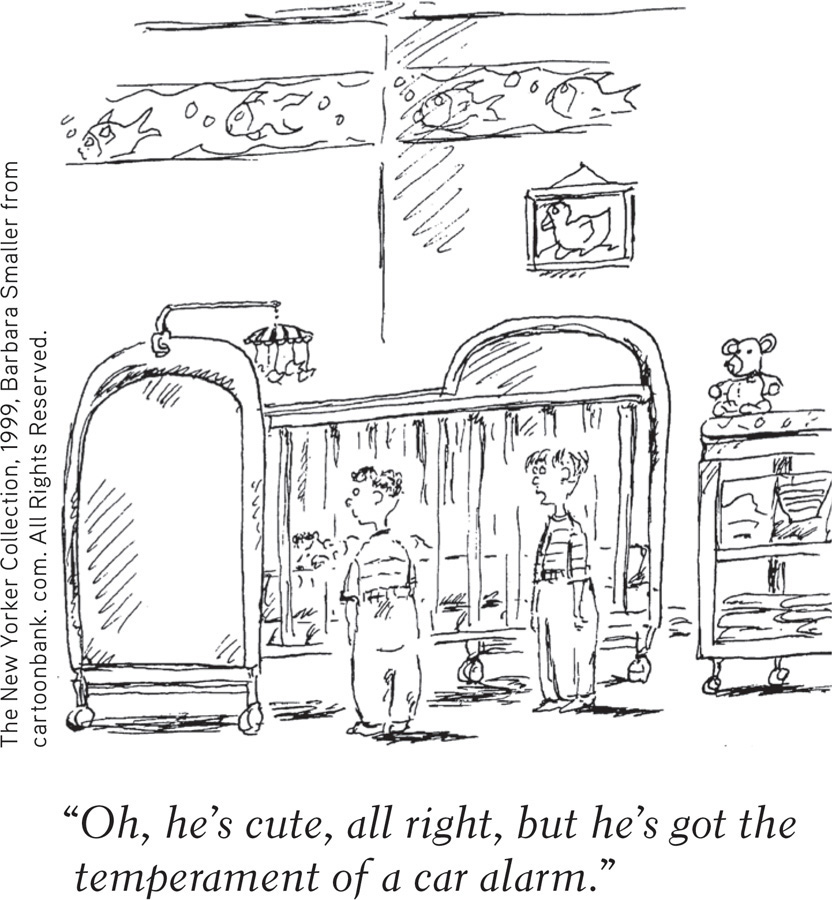
As most parents will tell you after having their second child, babies differ even before gulping their first breath. One aspect of personality—
Temperament differences typically persist. Consider:
- The most emotionally reactive newborns tended also to be the most reactive 9-
month- olds (Wilson & Matheny, 1986; Worobey & Blajda, 1989). - Exceptionally shy 6-
month- olds often were still shy as 13- year- olds; over 4 in 10 children rated as consistently shy developed anxiety problems in adolescence (Prior et al., 2000). - The most emotionally intense preschoolers tended to be relatively intense young adults (Larsen & Diener, 1987). In one study of more than 900 New Zealanders, emotionally reactive and impulsive 3-
year- olds developed into somewhat more impulsive, aggressive, and conflict- prone 21- year- olds (Caspi, 2000). 
Consider how researchers have studied these issues with LaunchPad’s How Would You Know If Personality Runs in the Genes? - Identical twins, more than fraternal twins, often have similar temperaments (Fraley & Tancredy, 2012; Kandler et al., 2013).
The genetic effect appears in physiological differences. Anxious, inhibited infants have high and variable heart rates and a reactive nervous system. When facing new or strange situations, they become more physiologically aroused (Kagan & Snidman, 2004; Roque et al., 2012). One form of a gene that regulates the neurotransmitter serotonin predisposes a fearful temperament and, in combination with unsupportive caregiving, an emotionally reactive child (Raby et al., 2012).
Heritability
4-
heritability the proportion of variation among individuals that we can attribute to genes. The heritability of a trait may vary, depending on the range of populations and environments studied.
So our biology helps form our personality. Yet asking whether our personality is more a product of our genes or our environment is like asking whether a flat-
Using twin and adoption studies, behavior geneticists can mathematically estimate the heritability of a trait—
141
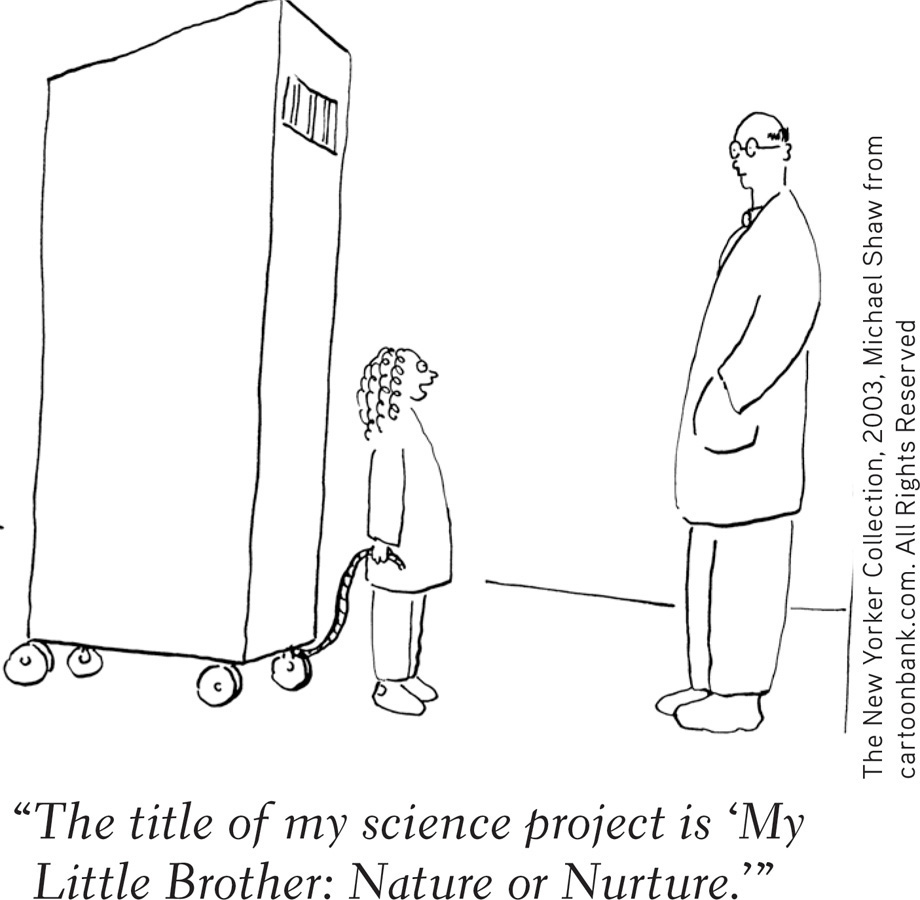
Even this conclusion must be qualified, because heritability can vary from study to study. Consider humorist Mark Twain’s (1835–1910) fictional idea of raising boys in barrels to age 12, feeding them through a hole. If we were to follow his suggestion, the boys would all emerge with lower-
As environments become more similar, heredity becomes the primary source of differences. If all schools were of uniform quality, all families equally loving, and all neighborhoods equally healthy, then heritability would increase (because differences due to environment would decrease). But consider the other extreme: If all people had similar heredities but were raised in drastically different environments (some in barrels, some in luxury homes), heritability would be much lower.
If genetic influences help explain variations in traits among individuals in a group, can the same be said of trait differences between groups? Not necessarily. As we have seen, height is 90 percent heritable, yet nutrition (an environmental factor) rather than genetic influences explains why, as a group, today’s adults are taller than those of a century ago. More available food has caused Americans to grow to greater heights (Floud et al., 2011). In 1850, the average American male stood 5 feet 7 inches; in the 1980s, his counterpart stood three inches taller. The two groups differ, but not because human genes have changed in a mere century’s eyeblink of time. And today’s South Koreans, with their better diets, average six inches taller than today’s North Koreans, who come from the same genetic stock (Johnson et al., 2009). Genes matter, but so does environment.
As with height and weight, so with personality and intelligence scores: Heritable individual differences need not imply heritable group differences. If some individuals are genetically disposed to be more aggressive than others, that needn’t explain why some groups are more aggressive than others. Putting people in a new social context can change their aggressiveness. Today’s peaceful Scandinavians carry many genes inherited from their Viking warrior ancestors.
Question
ghNGZv146XS3aSDpCWO/yyrUQSRzpoc3RNPP71ezqGcBdH0/K2tRPJyBYx1XTwemY9LsuWBhpZUdqigtkX223PI1ZvFcWV3zB9mxYNfbuadGyoGLKDG7aRAB948hgqT1cJIWQZwWOiJzzNnN7RM/j3foqS8Vhnx+xNkmNrhcaRoi2SdorKbPWuwD4qPWC8th+oougck9AKBNUb30FK2gcnIqWJk4XFUM2E4HCB4Rd8olSfqV1nR9cIM59MLah1LjY35hHbEZ6xs6gpHPd2f/5zW8m0E= For a 7-
For a 7-
RETRIEVAL PRACTICE
- Those studying the heritability of a trait try to determine how much of the person-
to- person variation in that trait among members of a specific group is due to their differing ______________.
genes
142
Gene–Environment Interaction
“Men’s natures are alike; it is their habits that carry them far apart.”
Confucius, Analects, 500 b.c.e.
Among our similarities, the most important—
“Heredity deals the cards; environment plays the hand.”
Psychologist Charles L. Brewer (1990)
The New Frontier: Molecular Behavior Genetics
molecular genetics the subfield of biology that studies the molecular structure and function of genes.
4-
molecular behavior genetics the study of how the structure and function of genes interact with our environment to influence behavior.
Behavior geneticists have progressed beyond asking “Do genes influence behavior?” The new frontier of behavior-
Searching for Specific Genes Influencing Behavior Most human traits are influenced by teams of genes. For example, twin and adoption studies tell us that heredity influences body weight, but there is no single “obesity gene.” More likely, some genes influence how quickly the stomach tells the brain, “I’m full.” Others might dictate how much fuel the muscles need, how many calories are burned off by fidgeting, and how efficiently the body converts extra calories into fat (Vogel, 1999). Genes typically are not solo players. So, one goal of molecular behavior genetics is to find some of the many genes that together orchestrate complex traits such as body weight, sexual orientation, and impulsivity (Derringer et al., 2010; Holden, 2008; Tsankova et al., 2007).
epigenetics the study of environmental influences on gene expression that occur without a DNA change.
Genetic tests can now reveal at-
Searching for Triggers That Switch Genes On and Off Genes can be either active (expressed, as hot water activates the tea bag) or inactive. Epigenetics (meaning “in addition to” or “above and beyond” genetics), studies the molecular mechanisms by which environments can trigger or block genetic expression. Genes are self-
Our experiences also lay down epigenetic marks, which are often organic methyl molecules attached to part of a DNA strand (FIGURE 4.3). If a mark instructs the cell to ignore any gene present in that DNA segment, those genes will be “turned off”—they will prevent the DNA from producing the proteins normally coded by that gene. As one geneticist said, “Things written in pen you can’t change. That’s DNA. Things written in pencil you can. That’s epigenetics” (Reed, 2012).

 Figure 4.3
Figure 4.3Epigenetics influences gene expression Life experiences beginning in the womb lay down epigenetic marks—
143
THINKING CRITICALLY ABOUT
Prenatal Testing to Predict Future Traits
4-
In labs worldwide, molecular geneticists are teaming with psychologists to pinpoint genes that put people at risk for genetically influenced disorders. One worldwide research effort is sleuthing the genes that make people vulnerable to the emotional swings of bipolar disorder, formerly known as manic-
Even so, aided by inexpensive DNA-
Progress is a double-
Environmental factors such as diet, drugs, and stress can affect the epigenetic molecules that regulate gene expression. Mother rats normally lick their infants. Deprived of this licking, infant rats in one experiment had more epigenetic molecules blocking access to their brain’s “on” switch for developing stress hormone receptors. When stressed, those animals had above-
Researchers now wonder if epigenetics might help solve some scientific mysteries, such as why only one member of an identical twin pair may develop a genetically influenced mental disorder, and how childhood abuse leaves its fingerprints in a person’s brain (Spector, 2012). Epigenetics can also help explain why identical twins may look slightly different. Researchers studying mice have found that in utero exposure to certain chemicals can cause genetically identical twins to have different-
Question
y8sk0YukKjov4FznrUhR0Qah5/v80jrUzjMTszkBjK7aZ0o4brqOeLKfMVDN5t0ootGtV6+mjCEFKFHfTZoJKlZ1KO8lackUM235gvAYzrmeawZT8wshZkC0pby1rRnvlvfy3W3/WwjMckuqsW4sib3myUFj8tA3HiyBdQgBY/XuXRnCS3N9rMDBY9I1mZvv8+rdI3QUpgil47Lz1ecbBQ==RETRIEVAL PRACTICE
- Match the following terms to the correct explanation.
- Epigenetics
- Molecular behavior genetics
- Behavior genetics
- Study of the relative effects of our genes and our environment on our behavior.
- Study of how the structure and function of specific genes interact with our environment to influence behavior.
- Study of environmental factors that affect how our genes are expressed.
1. c, 2. b, 3. a
144